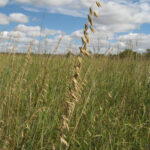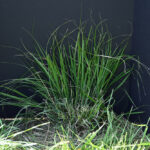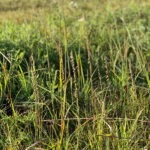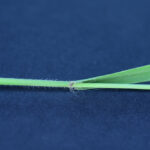Side-oats Grama
Bouteloua curtipendula
General Description
Side-oats grama is a native warm season perennial bunchgrass that may have short rhizomes. The deep fibrous roots help it to access soil moisture even in dry periods. As a mid-height grass, side-oats grama provides a reliable forage source in native stands.
Stems can grow 10 to 80 cm tall, but most often stays short growing on the Canadian prairies. Leaves begin at the base and are evenly spaced up the stem. Leaves are generally 2 to 30 cm long and 2.5 to 7 mm wide. Long, fine hairs are found on the lower leaf edges close to the base of the leaf, and the sheath can often be reddish-purple. The leaves are more stiff, broad, and upright than blue grama. As the green to blue-green leaves dry down they turn orangey-pink.
At the top of each stem is a long seed head, where the 2-sided seed clusters hang downward together. Seed heads are 10-30 cm long with 20 to 50 tiny seed clusters. While side-oats grama is found across the prairies, it is most commonly found in abundance in the black soil zone in eastern Saskatchewan and southern Manitoba.
Type
Native grass.
Origin
Native. Found most often in the eastern Mixed Grass Prairie and Tall Grass Prairie of Saskatchewan and Manitoba.
Longevity
Long-lived.
Use
Reclamation, pasture, stockpiled.
Optimal Time of Use
Mid-summer, fall, winter. Initiates growth in early summer. Cures well on the stem remaining palatable through winter.
Recovery After Use
Should be grazed once per year to ensure stand longevity. Is noted to be sensitive to overgrazing.
Palatability/Nutritional Value
Noted to have good palatability and nutritional value. Results of nutritional value studies vary greatly. As it matures and becomes coarser, palatability decreases moderately.
Annual Precipitation min/max (mm)
304mm / 635mm
Drought Tolerance
Good to excellent tolerance. Deep roots allow continued growth during dry conditions.
Flooding Tolerance
Withstands up to 2 weeks of spring flooding.
Winter Hardiness
Good hardiness.
Soil Texture Preference
Adapted to a wide range of soil texture, from sandy-loam through clay soils. Can be found on hilly or eroded and stony sites.
Erosion Control
Moderate ability to control erosion. Grows deep fibrous roots and sometimes very short rhizomes.
Salinity Tolerance
Slight tolerance.
Acidity Tolerance
Moderate tolerance.
Alkalinity Tolerance
Low to moderate tolerance.
Seeds per kg
421,000 seeds/kg (191,000 seeds/lb)
Suggested Mixtures
Plant with regionally adapted warm and cool season native species for reclamation and grazing. Successful if seeded by itself.
Ease of Establishment
Side-oats grama seedlings are vigorous. Germination testing of seed lots should be carried out as it is often lower than anticipated. Harvested seed can be a mix of spikes, individual spikelets, and sterile or fertile florets (two sterile florets for every one fertile floret).
Competitiveness
Warm season grasses, such as side-oats grama, are less competitive with highly productive cool season grasses or weeds because they start to grow when the cool season plants are at peak growth.
Management Considerations
Would be best utilized for sculpture seeding of sensitive hilltops and/or erodible areas. Early-summer grazing or mowing of cool-season species in the mixture is likely to give this warm-season grass the opportunity to co-exist with aggressive cool-season grasses. Provide adequate rest following grazing to stands containing side-oats grama. As a mid height grass, it is less resistant to grazing than blue grama. Select cultivars that originated from northern latitudes (such as the Dakotas) for highest suitability to cold, dry conditions. Seed stands respond positively to nitrogen fertilization.
AAFC Field Guide to Selected Native Forages, USDA Plants Database, Manitoba Forage Adaptation and Comparison Guide, USDA Fire Effects Information System, AAFC data unpublished.



